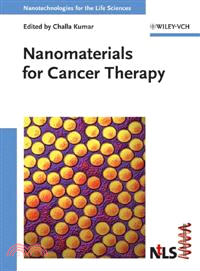NANOMATERIALS FOR CANCER THERAPY
商品資訊
ISBN13:9783527313860
出版社:JOHN WILEY & SONS;LTD
作者:KUMAR
出版日:2006/06/23
裝訂/頁數:精裝/434頁
商品簡介
A valuable single source gathering the many articles published in specialized journals often difficult to locate for members of the other disciplines involved.
作者簡介
目次
1 Conventional Chemotherapeutic Drug Nanoparticles for Cancer Treatment (Loredana Serpe).
1.1 Introduction.
1.2 Cancer as Drug Delivery Target.
1.3 Nanoparticles as Anticancer Drug Delivery System.
1.3.1 Conventional Nanoparticles.
1.3.2 Sterically Stabilized Nanoparticles.
1.3.3 Actively Targetable Nanoparticles.
1.3.4 Routes of Drug Nanoparticles Administration.
1.4 Anticancer Drug Nanoparticles.
1.4.1 Anthracyclines.
1.4.1.1 Reverse of P-glycoprotein Mediated Multidrug Resistance of Cancer Cells to Doxorubicin.
1.4.2 Antiestrogens.
1.4.3 Anti-metabolites.
1.4.4 Camptothecins.
1.4.5 Cisplatin.
1.4.6 Paclitaxel.
1.4.7 Miscellaneous Agents.
1.4.7.1 Arsenic Trioxide.
1.4.7.2 Butyric Acid.
1.4.7.3 Cystatins.
1.4.7.4 Diethylenetriaminepentaacetic Acid.
1.4.7.5 Mitoxantrone.
1.4.8 Gene Therapy.
References.
2 Nanoparticles for Photodynamic Therapy of Cancer (Magali Zeisser-Laboue`be, Angelica Vargas, and Florence Delie).
2.1 Introduction.
2.2 Concept and Basis of Photodynamic Therapy and Photodetection.
2.2.1 Mechanisms of Photodynamic Therapy and Photodiagnosis.
2.2.2 Selective Tumor Uptake of Photosensitizers.
2.2.3 Photosensitizers.
2.2.3.1 Conventional Photosensitizers.
2.2.3.2 New Entities.
2.2.4 Photodynamic Therapy: Advantages and Limitations.
2.2.5 Photosensitizer Formulations.
2.3 Non-biodegradable Nanoparticles for Photodynamic Therapy.
2.3.1 Metallic Nanoparticles.
2.3.2 Ceramic Nanoparticles.
2.3.3 Nanoparticles Made of Non-biodegradable Polymers.
2.4 Biodegradable Polymeric Nanoparticles for Photodynamic Therapy.
2.4.1 Preparation of Biodegradable Polymeric Nanoparticles.
2.4.1.1 In situ Polymerization.
2.4.1.2 Dispersion of a Preformed Polymer.
2.4.1.3 "Stealth" Particles.
2.4.1.4 Targeted Nanoparticles.
2.4.2 In Vitro Relevance of Polymeric Nanoparticles in PDT on Cell Models.
2.4.2.1 Photodynamic Activity of PS-loaded Nanoparticles.
2.4.2.2 Uptake and Trafficking of Photosensitizers.
2.4.3 In Vivo Relevance of Polymeric Nanoparticles in PDT.
2.4.3.1 Biodistribution and Pharmacokinetics of Photosensitizers Coupled to Nanoparticles.
2.4.3.2 Vascular Effects.
2.4.3.3 In Vivo Efficacy on Tumor: Tumor Suppression Effects.
2.4.3.4 Adverse Effects.
2.5 Conclusions.
Acknowledgments.
Abbreviations.
References.
3 Nanoparticles for Neutron Capture Therapy of Cancer (Hideki Ichikawa, Hiroyuki Tokumitsu, Masahito Miyamoto, and Yoshinobu Fukumori)
3.1 Introduction.
3.2 Principle of Neutron Capture Therapy of Cancer.
3.3 Boron Neutron Capture Therapy.
3.3.1 Boron Compounds.
3.3.2 Delivery of Boron Using Nanoparticles.
3.4 Approaches to GdNCT.
3.4.1 Typical Research on GdNCT.
3.4.2 Delivery of Gadolinium using Lipid Emulsion (Gd-nanoLE).
3.4.2.1 Preparation of Gd-nanoLE.
3.4.2.2 Biodistribution of Gadolinium after Intraperitoneal Administration of Gd-nanoLE.
3.4.2.3 Biodistribution of Gadolinium after Intravenous Administration of Gd-nanoLE.
3.4.3 Delivery of Gadolinium using Chitosan Nanoparticles (GdnanoCPs).
3.4.3.1 Preparation of Gd-nanoCPs.
3.4.3.2 Gd-DTPA Release Property of Gd-nanoCPs.
3.4.3.3 Gd-DTPA Retention in Tumor Tissue after Intratumoral Injection.
3.4.3.4 In vivo Growth Suppression of Experimental Melanoma Solid Tumor.
3.4.3.5 Bioadhesion and Uptake of Gd-nanoCP in Three Different Cell Lines.
3.5 Conclusions.
References.
4 Nanovehicles and High Molecular Weight Delivery Agents for Boron Neutron Capture Therapy (Gong Wu, Rolf F. Barth, Weilian Yang, Robert Lee, Werner Tjarks, Marina V. Backer, and Joseph M. Backer)
4.1 Introduction.
4.1.1 Overview.
4.1.2 General Background.
4.2 General Requirements for Boron Delivery Agents.
4.3 Low Molecular Weight Delivery Agents.
4.4 High Molecular Weight Boron Delivery Agents.
4.5 Dendrimer-related Delivery Agents.
4.5.1 Properties of Dendrimers.
4.5.2 Boronated Dendrimers Linked to Monoclonal Antibodies.
4.5.2.1 Boron Clusters Directly Linked to mAb.
4.5.2.2 Attachment of Boronated Dendrimers to mAb.
4.5.3 Boronated Dendrimers Delivered by Receptor Ligands.
4.5.3.1 Epidermal Growth Factors (EGF).
4.5.3.2 Folate Receptor Targeting Agents.
4.5.3.3 Vascular Endothelial Growth Factor (VEGF).
4.5.4 Other Boronated Dendrimers.
4.6 Liposomes as Boron Delivery Agents.
4.6.1 Overview of Liposomes.
4.6.2 Liposomal Encapsulation of Sodium Borocaptate and Boronophenylalanine.
4.6.2.1 Boron Delivery by Non-targeted Liposomes.
4.6.2.2 Liposomal Encapsulation of other Boranes and Carboranes.
4.6.3 Boron Delivery by Targeted Liposomes.
4.6.3.1 Immunoliposomes.
4.6.3.2 Folate Receptor-targeted Liposomes.
4.6.3.3 EGFR Targeted Liposomes.
4.7 Boron Delivery by Dextrans.
4.8 Other Macromolecules used for Delivering Boron Compounds.
4.9 Delivery of Boron-containing Macromolecules to Brain Tumors.
4.9.1 General Considerations.
4.9.2 Drug-transport Vectors.
4.9.3 Direct Intracerebral Delivery.
4.9.4 Convection-enhanced Delivery (CED).
4.10 Clinical Considerations and Conclusions.
Acknowledgments.
References.
5 Local Cancer Therapy with Magnetic Drug Targeting using Magnetic Nanoparticles (Christoph Alexiou and Roland Jurgons)
5.1 Introduction.
5.2 Local Chemotherapy.
5.3 Magnetic Drug Delivery.
5.3.1 In Vitro Applications.
5.3.2 In Vivo Applications.
References.
6 Nanomaterials for Controlled Release of Anticancer Agents (Do Kyung Kim, Yun Suk Jo, Jon Dobson, Alicia El Haj, and Mamoun Muhammed).
6.1 Introduction.
6.2 Nanoparticles for Biomedical Applications.
6.2.1 First Generation Nanoparticles.
6.2.2 Second Generation Nanoparticles.
6.2.3 Advanced Generation Nanoparticles.
6.3 Polymer Materials for Drug Delivery Systems.
6.4 Design of Drug Delivery Vectors and Their Prerequisites.
6.4.1 Polymeric Nanoparticles.
6.4.2 Inorganic Nanoparticles.
6.4.3 Metallic Nanoparticles.
6.5 Kinetics of the Controlled Release of Anticancer Agents.
6.5.1 Diffusion Model.
6.5.2 Dissolution Model.
6.5.3 Kinetics of the Indomethacin (IMC, 1-[p-chlorobenzoyl]-2-methyl-5-methoxy-3-indoleacetic acid) Release.
6.6 Controlled Release of Anticancer Agents.
6.6.1 Alkylating Agents.
6.6.1.1 Chlorambucil.
6.6.1.2 Cyclophosphamide.
6.6.1.3 Carmustine.
6.6.2 Antimetabolic Agent.
6.6.2.1 Cytarabine.
6.6.2.2 Fluorouracil (FU).
6.6.2.3 Methotrexate.
6.6.3 Anticancer Antibiotics.
6.6.3.1 Actinomycin D.
6.6.3.2 Bleomycin.
6.6.3.3 Daunorubicin.
6.7 Future Directions.
References.
7 Critical Analysis of Cancer Therapy using Nanomaterials (Lucienne Juillerat-Jeanneret).
7.1 Introduction.
7.2 Anticancer Therapies.
7.3 Characteristics of Nanoparticles for Cancer Therapy.
7.3.1 Nanovectors.
7.3.2 Biological Issues.
7.3.3 Nanoparticle Targeting: Passive or Active.
7.4 Nanovectors in Biomedical Applications: Drug Delivery Systems (DDS) for Cancer.
7.4.1 Physicochemical Drug Delivery.
7.4.2 Biological Drug Delivery.
7.4.3 Chemical Drug Delivery.
7.4.4 Nanoparticles for Anticancer Drug Delivery.
7.4.4.1 Existing Systems.
7.4.4.2 Systems under Development and Challenges.
7.4.5 Nanoparticles for Drug Delivery in Clinical Use or under Clinical Evaluation.
7.4.5.1 Doxorubicin Family.
7.4.5.2 Paclitaxel (Taxol).
7.4.5.3 5-Fluorouracil.
7.4.5.4 Tamoxifen.
7.4.5.5 Cisplatin.
7.4.5.6 Campthotecins.
7.4.5.7 Methotrexate.
7.4.6 New Experimental Drugs and Therapies.
7.4.6.1 Proteins, Peptides, their Inhibitors and Antagonists.
7.4.6.2 New Drugs.
7.4.6.3 New Therapeutic Approaches: Photodynamic Therapy (PDT).
7.4.7 Gene Therapy.
7.4.7.1 Nanoparticle for Gene Delivery: Non-chitosan and Chitosan-type Polymers.
7.4.8 New Approaches.
7.4.8.1 Improvement of Biological Characteristics.
7.4.8.2 New Technological Approaches.
7.4.9 Superparamagnetic Iron Oxide Nanoparticles (SPIONs) as Magnetic Drug Nanovectors.
7.5 Targeting.
7.5.1 Passive Targeting.
7.5.2 Active Targeting.
7.5.2.1 Targeting Cancer-associated Cells.
7.5.2.2 Targeting Cancer Markers.
7.5.3 Intracellular Drug Delivery.
7.5.4 Development of the Necessary Chemistry: Synthetic Routes and Linkers for Conjugation.
7.6 Overcoming the Mechanisms of Resistance to Therapy of Cancers.
7.7 Toxicity Issues.
7.8 Conclusions.
7.8.1 Opportunities and Challenges of Nanomedicine in Cancer.
References.
8 Nanoparticles for Thermotherapy (Andreas Jordan, Klaus Maier-Hauff, Peter Wust, and Manfred Johannsen).
8.1 Introduction.
8.2 Thermotherapy following Intratumoral Administration of Magnetic Nanoparticles.
8.3 Ferromagnetic Embolization Hyperthermia.
8.4 First Clinical Experiences with Thermotherapy using Magnetic Nanoparticles: MagForce Nanotherapy.
8.4.1 Feasibility Study on Thermotherapy using Magnetic Nanoparticles in Recurrent Glioblastoma Multiforme.
8.4.2 Feasibility Study on Thermotherapy using Magnetic Nanoparticles in Recurrent and Residual Tumors.
8.4.3 Feasibility Study on Thermotherapy using Magnetic Nanoparticles in Recurrent Prostate Carcinoma.
References.
9 Ferromagnetic Filled Carbon Nanotubes as Novel and Potential Containers for Anticancer Treatment Strategies (Ingolf Moench, Axel Meye, and Albrecht Leonhardt).
9.1 Introduction.
9.2 Prostate Cancer.
9.2.1 Incidence, Risk Factors and Diagnostic Criteria.
9.2.2 Treatment Options, Outcome and Limits.
9.2.3 MWCNT Model.
9.3 Carbon Nanotubes.
9.3.1 General Remarks.
9.3.2 Preparation and Structure of Filled Multi-walled Carbon Nanotubes.
9.3.2.1 Synthesis of Ferromagnetic Filled Multi-walled Carbon Nanotubes.
9.3.2.2 Crystallographic Structure of Core Material in Filled Multi-walled Carbon Nanotubes.
9.3.2.3 Growth Mechanism of Multi-walled Carbon Nanotubes.
9.3.3 Post-treatment: Opening, Filling and Closing of MWCNTs.
9.4 Magnetism in Nano-sized Materials.
9.4.1 General Remarks.
9.4.2 Magnetization in Nano-sized Materials.
9.4.3 Influence of the Dimensions on the Magnetization Distribution.
9.4.4 Anisotropy and Interaction.
9.4.5 Magnetic Reversal.
9.4.6 Magnetic Properties of Filled Multi-walled Carbon Nanotubes.
9.5 Heat Generation.
9.5.1 General Remarks.
9.5.2 Requirements for the Development of Materials for Hyperthermia and Magnetism.
9.5.3 Specific Absorption Rate (SAR).
9.6 Study Results for In Vitro and In Vivo Applications of ff-MWCNTs.
9.6.1 Efficient Endocytosis In Vitro, Lipid-mediated Could Enhance the Internalization Rate and Efficiency.
9.6.2 Production of Two Types of ff-MWCNTs for In Vivo Application.
9.6.3 Outlook/Next Steps in Evaluation of these ffff-MWCNTs.
Acknowledgments.
Abbreviations.
References.
10 Liposomes, Dendrimers and other Polymeric Nanoparticles for Targeted Delivery of Anticancer Agents – A Comparative Study (Yong Zhang and Dev K. Chatterjee).
10.1 Introduction.
10.2 Cancer Chemotherapy: so Far, but not so Good.
10.3 Nanoparticles and Drug Delivery in Cancer: a new Road.
10.3.1 Importance of Nanoparticles in Cancer Therapy.
10.3.2 An Overview of Targeting Methods.
10.4 Means to the End: Methods for Targeting.
10.4.1 Passive Targeting.
10.4.2 Magnetic Targeting of Nanoparticles.
10.4.3 Ligands for Active Targeting.
10.4.3.1 Monoclonal Antibodies against Tumor-specific Antigens.
10.4.3.2 Targeting the Angiogenic Process.
10.4.3.3 Folic Acid and Cancer Targeting.
10.4.3.4 Transferrin as a Targeting Ligand.
10.4.3.5 Other Targeting Ligands.
10.5 Targeting with Different Types of Nanoparticles.
10.5.1 Liposomes in Cancer Targeting.
10.5.1.1 Beyond Immunoliposomes.
10.5.2 Dendrimers.
10.5.3 Other Polymeric Nanoparticles.
10.6 Conclusion.
References.
11 Colloidal Systems for the Delivery of Anticancer Agents in Breast Cancer and Multiple Myeloma (Sébastien Maillard, Elias Fattal, Véronique Marsaud, Brigitte Sola, and Jack-Michel Renoir).
11.1 Introduction.
11.2 Hormone Therapy in Breast Cancers.
11.2.1 Molecular Mechanisms of Estrogen Action in Breast Cancers.
11.2.1.1 Classical ER-ligand and ERE-dependent Mechanism.
11.2.1.2 ERE-independent Pathway.
11.2.1.3 ER-ligand-independent Pathway.
11.2.1.4 "Non-genomic" Pathway.
11.2.2 Differential Activity of Antiestrogens.
11.2.3 The Need to Encapsulate Antiestrogens.
11.3 Multiple Myeloma.
11.3.1 Current Treatments.
11.3.2 New Biological Therapies for MM Treatment.
11.3.3 Incidence of Estrogens and Antiestrogens on Multiple Myeloma.
11.4 Colloidal Systems for Antiestrogen Delivery.
11.4.1 Nanoparticles Charged with AEs in Breast Cancer.
11.4.2 Liposomes Charged with RU 58668 in MM.
11.4.3 Tumor-targeted Drug-loaded Colloidal Systems.
11.5 Conclusions and Perspectives.
Acknowledgments.
References.
Index.
主題書展
更多書展今日66折
您曾經瀏覽過的商品
購物須知
外文書商品之書封,為出版社提供之樣本。實際出貨商品,以出版社所提供之現有版本為主。部份書籍,因出版社供應狀況特殊,匯率將依實際狀況做調整。
無庫存之商品,在您完成訂單程序之後,將以空運的方式為你下單調貨。為了縮短等待的時間,建議您將外文書與其他商品分開下單,以獲得最快的取貨速度,平均調貨時間為1~2個月。
為了保護您的權益,「三民網路書店」提供會員七日商品鑑賞期(收到商品為起始日)。
若要辦理退貨,請在商品鑑賞期內寄回,且商品必須是全新狀態與完整包裝(商品、附件、發票、隨貨贈品等)否則恕不接受退貨。
























